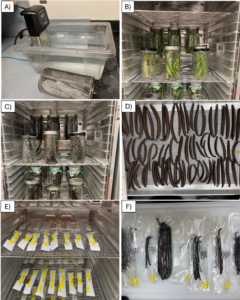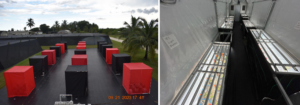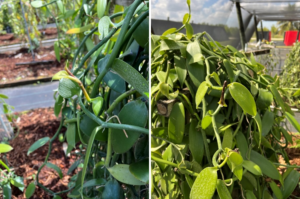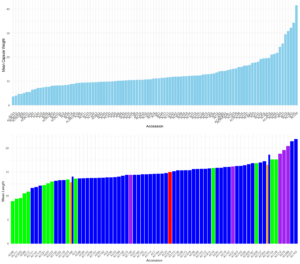Progress report for LS23-381
Project Information
Vanilla is among the highest grossing agricultural commodities by weight, and could revitalize the distressed subtropical agricultural industry. The primary commercial species, V. planifolia, is native to North and Central America, but Madagascar is today’s leading vanilla producer. The United States is the largest importer of cured vanilla beans, but domestic production is currently limited. Domestic vanilla production is becoming increasingly attractive as international supplies are perennially strained and demand for vanilla extract increases as companies like MARS, Unilever, and Nestlé pledge to remove artificial ingredients from their products (Andriamahery and Zhou, 2018; Brownell, 2011; Terazomo, 2017). Growing vanilla beans has the potential to support growers in Florida, Puerto Rico, and the US Virgin Islands striving to meet an evolving consumer base favoring local, organic, and natural products (Chambers, 2018; Perez-silva et al., 2006). Vanilla also encourages agroforestry and sustainability because it grows in shade and is often cultivated in an agroforestry setting. This natural habitat, combined with the beauty and exoticism of the plant, makes it attractive for agritourism, providing an additional source of revenue for vanilla farmers and nearby rural communities. Indeed, vanilla has the potential to thrive in Florida, Puerto Rico, and the US Virgin Islands with adapted material producing gourmet-class beans (see Figure 1). Unlike most crops, vanilla has not been domesticated through plant improvement, and today’s industry relies on cultivated, wild clones (Soto-Arenas and Cameron, 2003). Little information is available about which clones are most suitable and productive for a given region and climate. The biggest challenge inhibiting domestic vanilla production has been the lack of appropriate planting material and scientifically-validated growing information. Therefore, even when vanilla reached a peak of $600/kg in 2019 (~$1.5M per acre gross value), domestic growers were not in a position to benefit from this market. Additionally, the emerging domestic vanilla market requires a supply chain to move product efficiently from farm to end users. Therefore, this project was designed to overcome these challenges and could have major impacts on productivity, profitability, and rural communities. Because of the location of the project, the farmers and communities that would benefit have a high proportion of underrepresented groups. Objectives of this project include 1) Research and development, 2) Extension and grower trials, and 3) Market development and supply chain analysis.
Objective 1. Research and development
1.1 Identify elite vanilla planting material from UF diversity collection including high-yielding types.
1.2 Analyze bean quality through HPLC analysis of vanilla extract.
1.3 Determine optimal shade level to accelerate vanilla plant growth in Florida.
1.4 Communicate results through peer-reviewed publications, public seminars, and grower documents.
Objective 2. Extension and grower trials
2.1 Propagate selected plant material and distribute to grower cooperators
2.2 Distribute growing information to social disadvantaged grower cooperators in English and Spanish
2.3 Collect data from grower plots
2.4 Organize grower field days, symposia, virtual seminars
Objective 3. Analyze market and supply chain development
3.1 Advance farm-to-business activities through pilot projects
3.2 Conduct market analyses
3.3 Hold participatory workshops, facilitate networking events, and establish pilot projects
Cooperators
- - Producer
- - Producer
- - Producer
- - Producer
- - Producer
- - Producer
- - Producer
- - Producer
- - Producer
Research
Objective 1.1 Identify elite vanilla planting material through germplasm evaluation. The flowers of vanilla were pollinated from January to April of 2023. Those beans were harvested from November 2023 to January 2024 and subsequently processed and cured for six months. A total of 48 accessions from the vanilla collection were analyzed for average bean length, bean weight, and vanillin content in 2024. In addition to the over bean quality, overall plant health, growth rate and adaptability were also used to select material for distribution to participating growers.
Figure 1. Vanilla collection in bean production.
Objective 1.2 Analyze bean quality through chemical analysis of vanilla extract. These beans were harvested and cured using traditional methods for vanillin quantification to determine bean quality. The mature beans were heat processed at 63°C for 5 minutes, sweating at 50°C for 72 hours, drying to 25% moisture at 32°C for 2-4 weeks depending on the bean size, and conditioned for six months before extraction with 50% food grade ethanol. The LC MS/MS approach was used to evaluate the chemical compounds of that influence the flavor profile of vanilla. Additional 20 commercial beans sourced internationally were also used for the evaluation to compare with beans from the collection.
Figure 2. Vanilla processing and curing for chemical analysis.
Objective 1.3 Determine optimal shade level to accelerate vanilla plant growth in Florida. Vanilla is a slow growing plant that requires four years to reach maturity for fruit production. Vanilla is a CAM plant that grows under shade and low light conditions. Research shown both light quantity and quality have great impact to plant growth, which can be utilized to reduce the juvenile period, but the optimal combination is unknown. Therefore, a 2 × 3 factorial experimental design (two light spectrums and three shade levels) was established with three replicates for each treatment groups. Additional light experiment was conducted in controlled environment conditions to explore the genetic x light interactions with two light treatments (8% and 18% of light) and two V. planifolia accessions. A split complete block design with three replicates per treatment was applied. Plant height, leaf number, chlorophyll content (SPAD), and stem growth were recorded for the duration of the project.
Figure 3. Outdoor and indoor light experiments.
A great phenotypic variation was observed between the accessions in the collection (Figure 4). In general, Vanilla pompona accessions flowered approximately one month early than V. planifolia accessions in south Florida environment. V. pompona accessions exhibited higher cold tolerance as compared to V. planifolia with smaller bean length (Figure 4). Beans from V. planifolia were longer but lighter weight as compared to beans from V. pompona species (Figure 5). V. planifolia beans generally had higher vanillin content than V. pompona accessions. Few hybrids between the two species showed much higher vanillin content than the accessions from the parent species, indicting hybrid vigor. Based on plant adaptation, growth performance and bean quality, three vanilla accessions (two V. planifolia accessions and one V. tahitensis accession) were identified as initial vanilla planting material for distribution to cooperative growers.
Figure 4. Vanilla planifolia (left) and V. pompona (right) plant under cold stress.
Figure 5. Phenotypic evaluation of vanilla germplasm collection.
Vanilla is a popular spice crop that requires unique light conditions for optimal growth but the impact of light intensity and quality on its physiological processes remain to be understood. The outdoor light study examines the effects of light quality (natural and red light) and intensity (50%, 70%, and 90% shade levels) on CAM photosynthesis, physiology, morphology, and growth of V. planifolia. Results indicated that red light promotes plant growth as compared to natural light, but no variations was found between different light intensity treatments. In the indoor light study where approximately 10% and 20% light treatment effect were investigated, no difference was found between the light levels on plant growth, however interaction was found between accessions with different genetic background. The experiment is set to be repeated in 2025, where physiological measurements of CO₂ exchange will be incorporated using biochemical analysis between different treatments to reflect photosynthetic rates. Biometric parameters, i.e., leaf area, stem height, and biomass, will be re-measured.
Educational & Outreach Activities
Participation summary:
Given this is a new crop that have never being produced domestically, the extension and outreach efforts were mainly made through in-depth onsite consultation to Florida grower cooperators. With these efforts, three growers have established their plantation in 2024, with two additional growers to complete the infrastructure and plantation in 2025. The Cooperative of Producers and Processors of Vanilla in Puerto Rico was officially established and approved in the fall of 2023. The cooperative started with nine partners and has expanded to twenty with more pending applications. Extension articles have been published and distributed to growers and cooperators. Those articles were written in both English and Spanish for broader impact. One vanilla book (Vainilla Gastronomía y Agroturismo) was developed and published by two members of the vanilla cooperative at Puerto Rico. One marketing plan workbooks was produced in both English and Spanish for growers.
In 2024, the University of Florida IFAS extension hosted an In-Service Training of vanilla cultivation to train extension agents across the state. The event was well received with 23 participants, with 93% of participants reported knowledge gain. In Puerto Rico, demonstration of cooking using vanilla was shown to local agricultural festival and traditional tourism areas to have broader impact. Field days were hosted to demonstrate on farm vanilla cultivation in both Florida and Puerto Rico. Grower in U.S Virgin Island have established their farm and finalize the planting with the assistant from the corresponding Co-PI and PI. Economical survey was distributed to a wide range of audiences from both existing and potential growers, feedback indicated a great interest in cultivating this crop in a much wide geographic area with various of production approaches. Survey also indicated the needs for foundational knowledge in cultivation, availability of plant material and economics of this new crop. A multi-state vanilla workshop will be hosted on April 10th 2025, with the goal to education growers from three geographical areas on how to cultivate vanilla commercially. Recent findings from studies in this project will be presented to growers.
In Florida, plant samples have been received for disease diagnosis. Virus has been reported to be the major disease issue for vanilla in Florida. Fusarium root and stem rot has been found in both Florida and Puerto Rico. The data collection from vanilla farms in three areas will be implemented in 2025. Environment data such as humidity, temperature and light intensity will be collected from participant growers. Soil samples will be collected for analyses if applicable.




